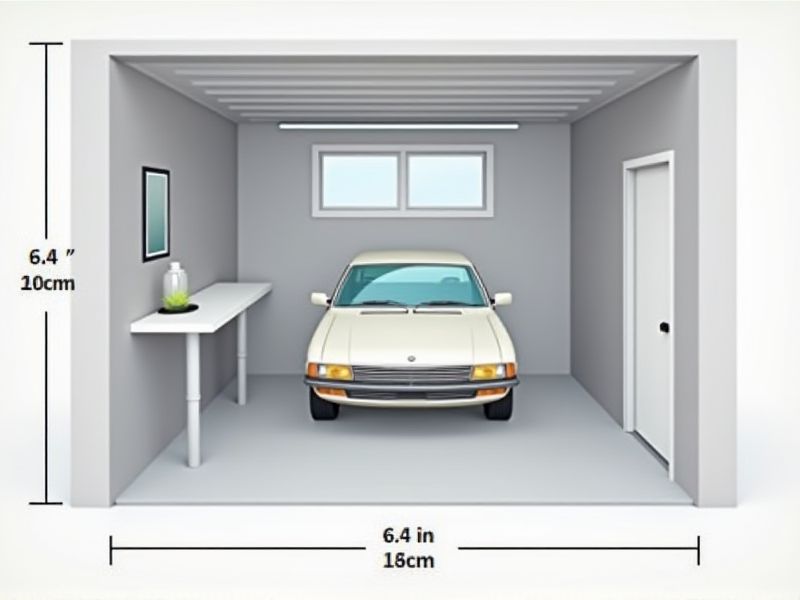
When planning a garage workspace, the standard dimensions typically range from 6 to 10 feet in depth and 8 to 16 feet in width, depending on the available garage space and the types of projects you plan to tackle. Ideally, a clear workspace of at least 6 feet by 8 feet provides enough room for a workbench, tool storage, and comfortable movement while working. If you plan on handling larger equipment or working on cars, increasing this area to at least 10 feet by 16 feet will offer better flexibility and safety. Remember to also factor in vertical space for shelving or wall-mounted storage to make the most of your garage workshop.
Ceiling Height
A standard garage workspace generally features a ceiling height of at least 8 to 10 feet, accommodating larger vehicles and enabling efficient movement during projects. This height allows for ample vertical storage options, maximizing your usable space with shelves, cabinets, or overhead storage systems. For hobbyists involved in activities like woodworking or automotive repairs, a minimum ceiling height of 9 feet is often recommended to facilitate the use of larger tools and machinery. Proper ceiling height not only enhances functionality but also improves air circulation, ensuring a comfortable working environment.
Door Width
The standard door width for a garage workspace typically ranges from 8 to 10 feet, allowing for ample room to maneuver vehicles and equipment. A width of 10 feet is particularly advantageous if you plan to store larger vehicles, such as trucks or SUVs. This measurement not only facilitates easy entry and exit but also enhances accessibility for tasks that require additional space. Ensuring your garage door meets these standards can significantly improve your overall functionality and efficiency in your garage environment.
Door Height
The standard height for garage doors typically ranges from 7 to 8 feet, accommodating most vehicles and ensuring ease of access. For a workspace that prioritizes functionality, consider a door height of at least 8 feet if you plan to store larger vehicles, like vans or trucks, to prevent any clearance issues. This elevation allows not only for vehicle access but also provides ample vertical space for overhead storage solutions, which can enhance the organization and usability of your garage space. When planning your garage workspace, aim for a minimum opening width of 9 to 10 feet to facilitate smooth entry and exit for various machinery and tools.
Wall Length
The standard wall length for a garage workspace typically ranges from 12 to 20 feet, providing ample room for tools, storage, and efficient movement. An optimal configuration allows for modular shelving and workbench setups that maximize usability within this space. Properly utilizing wall length also promotes better organization, allowing you to install pegboards or cabinets to keep your tools accessible and neatly arranged. Ensuring sufficient wall space can significantly enhance your overall productivity and workflow efficiency in the garage.
Wall Width
A standard garage workspace typically requires a wall width of at least 8 to 10 feet to ensure adequate maneuverability and functionality. This space allows for the installation of shelving, tool organizers, and workbenches, optimizing storage and workflow efficiency. With proper wall width, you can maximize your garage's potential by accommodating essential items without cluttering the area. Ensure you measure your garage dimensions accurately to create a comfortable and efficient workspace tailored to your needs.
Floor Space
A well-designed garage workspace should ideally have a minimum floor space of 200 square feet to facilitate various projects comfortably. This ample space allows for easy movement and access to tools, materials, and vehicles. Design considerations should include a clear path to accommodate your workflow and adequate storage solutions that maximize vertical space. Incorporating durable, easy-to-clean flooring materials can enhance both functionality and safety in this critical workspace.
Workspace Clearance
A well-organized garage workspace should maintain a minimum clearance of 3 feet around work areas for safety and efficiency. This clearance allows you to move freely, access tools, and perform tasks without obstruction. For optimal functionality, consider installing shelving at least 12 inches off the ground to maximize floor space while ensuring easy access to stored items. By implementing a pegboard wall for tool storage, you can minimize clutter, which contributes to a more productive environment.
Storage Area Dimensions
An ideal garage workspace features a storage area dimension of at least 12 feet long and 8 feet wide to accommodate shelves, cabinets, and tools effectively. For maximum organization, vertical storage solutions such as wall-mounted racks can utilize overhead space, helping to keep your garage clutter-free. Consider a clearance height of 7-8 feet to ensure easy access to overhead items while maintaining sufficient room for larger equipment. A well-planned storage area can enhance efficiency in your garage, allowing for smooth workflows and maximizing your usable space.
Electrical Outlet Placement
In a standard garage workspace, the optimal placement of electrical outlets is crucial for both safety and accessibility. Ideally, outlets should be installed every 6 feet along the walls, ensuring that all areas can easily access power sources. Consider incorporating GFCI outlets, which provide protection from electrical shock in potentially damp conditions, and place them at least 18 inches above the floor. This setup not only enhances convenience for tools and equipment but also supports an organized, efficient working environment.
Ventilation Areas
Proper ventilation in a garage workspace is crucial for maintaining air quality and safety, especially when using tools and chemicals. Aim for at least one square foot of ventilation per 100 square feet of workspace to allow for adequate airflow. Installing exhaust fans can help remove harmful fumes, while windows or vents can provide fresh air circulation. By prioritizing ventilation, you ensure a healthier environment that increases productivity and reduces the risk of accidents.
